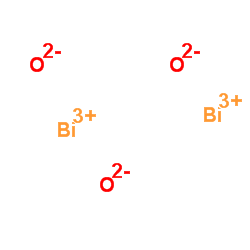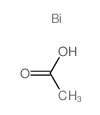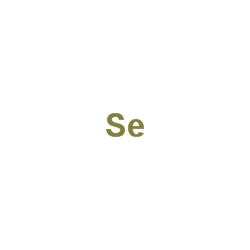Bismuth

Bismuth structure
|
Common Name | Bismuth | ||
|---|---|---|---|---|
| CAS Number | 7440-69-9 | Molecular Weight | 208.98000 | |
| Density | 9.8 g/mL at 25 °C(lit.) | Boiling Point | 1560 °C(lit.) | |
| Molecular Formula | Bi | Melting Point | 271 °C(lit.) | |
| MSDS | Chinese USA | Flash Point | N/A | |
| Symbol |

GHS02 |
Signal Word | Danger | |
| Name | bismuth atom |
|---|---|
| Synonym | More Synonyms |
| Density | 9.8 g/mL at 25 °C(lit.) |
|---|---|
| Boiling Point | 1560 °C(lit.) |
| Melting Point | 271 °C(lit.) |
| Molecular Formula | Bi |
| Molecular Weight | 208.98000 |
| Exact Mass | 208.98000 |
| Vapour Pressure | <0.1 mm Hg ( 20 °C) |
| InChIKey | JCXGWMGPZLAOME-UHFFFAOYSA-N |
| SMILES | [Bi] |
| Stability | Stable. Incompatible with strong acids, strong oxidizing agents, nitrosyl fluoride, fused ammonium nitrate, interhalogen compounds, chlorine. Finely-divided powder is highly flammable. |
| Water Solubility | insoluble |
|
SECTION 1: Identification of the substance/mixture and of the company/undertaking Product identifiers Product name: Bismuth REACH No.: A registration number is not available for this substance as the substance or its uses are exempted from registration, the annual tonnage does not require a registration or the registration is envisaged for a later registration deadline.
CAS-No.: 7440-69-9 Relevant identified uses of the substance or mixture and uses advised against Identified uses: Laboratory chemicals, Manufacture of substances SECTION 2: Hazards identification Classification of the substance or mixture Not a hazardous substance or mixture according to Regulation (EC) No. 1272/2008. This substance is not classified as dangerous according to Directive 67/548/EEC. Label elements The product does not need to be labelled in accordance with EC directives or respective national laws. Other hazards - none SECTION 3: Composition/information on ingredients Substances Formula: Bi Molecular Weight: 208,98 g/mol CAS-No.: 7440-69-9 EC-No.: 231-177-4 No components need to be disclosed according to the applicable regulations. SECTION 4: First aid measures Description of first aid measures If inhaled If breathed in, move person into fresh air. If not breathing, give artificial respiration. In case of skin contact Wash off with soap and plenty of water. In case of eye contact Flush eyes with water as a precaution. If swallowed Never give anything by mouth to an unconscious person. Rinse mouth with water. Most important symptoms and effects, both acute and delayed The most important known symptoms and effects are described in the labelling (see section 2.2) and/or in section 11 Indication of any immediate medical attention and special treatment needed no data available SECTION 5: Firefighting measures Extinguishing media Suitable extinguishing media Use water spray, alcohol-resistant foam, dry chemical or carbon dioxide. Special hazards arising from the substance or mixture Bismuth oxides Advice for firefighters Wear self contained breathing apparatus for fire fighting if necessary. Further information no data available SECTION 6: Accidental release measures Personal precautions, protective equipment and emergency procedures Avoid dust formation. Avoid breathing vapours, mist or gas. For personal protection see section 8. Environmental precautions No special environmental precautions required. Methods and materials for containment and cleaning up Sweep up and shovel. Keep in suitable, closed containers for disposal. Reference to other sections For disposal see section 13. SECTION 7: Handling and storage Precautions for safe handling Provide appropriate exhaust ventilation at places where dust is formed. For precautions see section 2.2. Conditions for safe storage, including any incompatibilities Store in cool place. Keep container tightly closed in a dry and well-ventilated place. Specific end use(s) Apart from the uses mentioned in section 1.2 no other specific uses are stipulated SECTION 8: Exposure controls/personal protection Control parameters Components with workplace control parameters Exposure controls Appropriate engineering controls General industrial hygiene practice. Personal protective equipment Eye/face protection Use equipment for eye protection tested and approved under appropriate government standards such as NIOSH (US) or EN 166(EU). Skin protection Handle with gloves. Gloves must be inspected prior to use. Use proper glove removal technique (without touching glove's outer surface) to avoid skin contact with this product. Dispose of contaminated gloves after use in accordance with applicable laws and good laboratory practices. Wash and dry hands. The selected protective gloves have to satisfy the specifications of EU Directive 89/686/EEC and the standard EN 374 derived from it. Full contact Material: Nitrile rubber Minimum layer thickness: 0,11 mm Break through time: 480 min Material tested:Dermatril® (KCL 740 / Z677272, Size M) Splash contact Material: Nitrile rubber Minimum layer thickness: 0,11 mm Break through time: 480 min Material tested:Dermatril® (KCL 740 / Z677272, Size M) data source: KCL GmbH, D-36124 Eichenzell, phone +49 (0)6659 87300, test method: EN374 If used in solution, or mixed with other substances, and under conditions which differ from EN 374, contact the supplier of the CE approved gloves. This recommendation is advisory only and must be evaluated by an industrial hygienist and safety officer familiar with the specific situation of anticipated use by our customers. It should not be construed as offering an approval for any specific use scenario. Body Protection Choose body protection in relation to its type, to the concentration and amount of dangerous substances, and to the specific work-place., The type of protective equipment must be selected according to the concentration and amount of the dangerous substance at the specific workplace. Respiratory protection Respiratory protection is not required. Where protection from nuisance levels of dusts are desired, use type N95 (US) or type P1 (EN 143) dust masks. Use respirators and components tested and approved under appropriate government standards such as NIOSH (US) or CEN (EU). Control of environmental exposure No special environmental precautions required. SECTION 9: Physical and chemical properties Information on basic physical and chemical properties a) AppearanceForm: granular Colour: light grey b) Odourodourless c) Odour Thresholdno data available d) pHno data available e) Melting point/freezingMelting point/range: 271 °C pointMelting point/range: 272 °C f) Initial boiling point and 1.560 °C boiling range g) Flash pointno data available h) Evapouration rateno data available i) Flammability (solid, gas) no data available j) Upper/lowerno data available flammability or explosive limits k) Vapour pressure< 0,1 hPa at 20 °C l) Vapour densityno data available m) Relative density9,8 g/mL at 25 °C n) Water solubilityinsoluble o) Partition coefficient: n- no data available octanol/water p) Auto-ignitionno data available temperature q) Decompositionno data available temperature r) Viscosityno data available s) Explosive propertiesno data available t) Oxidizing propertiesno data available Other safety information no data available SECTION 10: Stability and reactivity Reactivity no data available Chemical stability Stable under recommended storage conditions. Possibility of hazardous reactions no data available Conditions to avoid no data available Incompatible materials Oxidizing agents, Halogens, acids Hazardous decomposition products Other decomposition products - no data available In the event of fire: see section 5 SECTION 11: Toxicological information Information on toxicological effects Acute toxicity LD50 Oral - rat - male and female - 2.000 mg/kg (OECD Test Guideline 401) Skin corrosion/irritation no data available Serious eye damage/eye irritation no data available Respiratory or skin sensitisation no data available Germ cell mutagenicity no data available Carcinogenicity IARC:No component of this product present at levels greater than or equal to 0.1% is identified as probable, possible or confirmed human carcinogen by IARC. Reproductive toxicity no data available Specific target organ toxicity - single exposure no data available Specific target organ toxicity - repeated exposure no data available Aspiration hazard no data available Additional Information Repeated dose toxicity - rat - male and female - Gavage - No observed adverse effect level - 1.000 mg/kg RTECS: EB2600000 Kidney disorders, Liver disorders, Dermatitis SECTION 12: Ecological information Toxicity Toxicity to daphnia and static test EC50 - Daphnia magna (Water flea) - > 100 mg/l - 48 h other aquatic(OECD Test Guideline 202) invertebrates Persistence and degradability no data available Bioaccumulative potential no data available Mobility in soil no data available Results of PBT and vPvB assessment PBT/vPvB assessment not available as chemical safety assessment not required/not conducted Other adverse effects no data available SECTION 13: Disposal considerations Waste treatment methods Product Offer surplus and non-recyclable solutions to a licensed disposal company. Contaminated packaging Dispose of as unused product. SECTION 14: Transport information UN number ADR/RID: -IMDG: -IATA: - UN proper shipping name ADR/RID: Not dangerous goods IMDG: Not dangerous goods IATA:Not dangerous goods Transport hazard class(es) ADR/RID: -IMDG: -IATA: - Packaging group ADR/RID: -IMDG: -IATA: - Environmental hazards ADR/RID: noIMDG Marine pollutant: noIATA: no Special precautions for user no data available SECTION 15 - REGULATORY INFORMATION N/A SECTION 16 - ADDITIONAL INFORMATION N/A |
CHEMICAL IDENTIFICATION
HEALTH HAZARD DATAACUTE TOXICITY DATA
|
| Symbol |

GHS02 |
|---|---|
| Signal Word | Danger |
| Hazard Statements | H228 |
| Precautionary Statements | P210-P370 + P378 |
| Personal Protective Equipment | Eyeshields;Gloves;type N95 (US);type P1 (EN143) respirator filter |
| Hazard Codes | F:Flammable |
| Risk Phrases | R11 |
| Safety Phrases | S16-S45-S36/37/39-S26 |
| RIDADR | UN 3264 8/PG 3 |
| WGK Germany | 1 |
| RTECS | EB2600000 |
| Packaging Group | III |
| Hazard Class | 8 |
| HS Code | 8106009090 |
| Precursor 10 | |
|---|---|
| DownStream 10 | |
| HS Code | 8106009090 |
|---|
|
Bismuth nanoparticles integration into heavy metal electrochemical stripping sensor.
Electrophoresis , doi:10.1002/elps.201400609, (2015) Between their many applications bismuth nanoparticles (BiNPs) are showing interest as pre-concentrators in heavy metals detection while being applied as working electrode modifiers used in electrochem... |
|
|
Effect of irrigation with Tetraclean on bacterial leakage of obturated root canals.
N. Y. State Dent. J. 80(3) , 39-43, (2014) The purpose of the study presented here was to evaluate the effect of Tetraclean, Hypoclean, Chlor-XTRA, 2% chlorhexidine and 6% sodium hypochlorite/17% EDTA as a final irrigant on bacterial leakage o... |
|
|
Hybrid nanoprobes of bismuth sulfide nanoparticles and CdSe/ZnS quantum dots for mouse computed tomography/fluorescence dual mode imaging.
J. Nanobiotechnology 13 , 76, (2015) X-ray computed tomography (CT) imaging can be used to reveal the three-dimensional structure of deep tissue with high spatial resolution. However, it cannot reveal molecular or cellular changes, and h... |
| UNII-U015TT5I8H |
| Bismuth |
| EINECS 231-177-4 |
| MFCD00134033 |
 CAS#:1304-76-3
CAS#:1304-76-3 CAS#:603-33-8
CAS#:603-33-8 CAS#:7787-60-2
CAS#:7787-60-2 CAS#:7787-58-8
CAS#:7787-58-8 CAS#:7787-63-5
CAS#:7787-63-5 CAS#:7787-64-6
CAS#:7787-64-6 CAS#:22306-37-2
CAS#:22306-37-2 CAS#:7787-62-4
CAS#:7787-62-4 CAS#:7732-18-5
CAS#:7732-18-5 CAS#:997-50-2
CAS#:997-50-2 CAS#:108202-26-2
CAS#:108202-26-2 CAS#:90591-48-3
CAS#:90591-48-3 CAS#:7440-36-0
CAS#:7440-36-0 CAS#:7782-99-2
CAS#:7782-99-2 CAS#:7782-49-2
CAS#:7782-49-2 CAS#:10025-68-0
CAS#:10025-68-0
